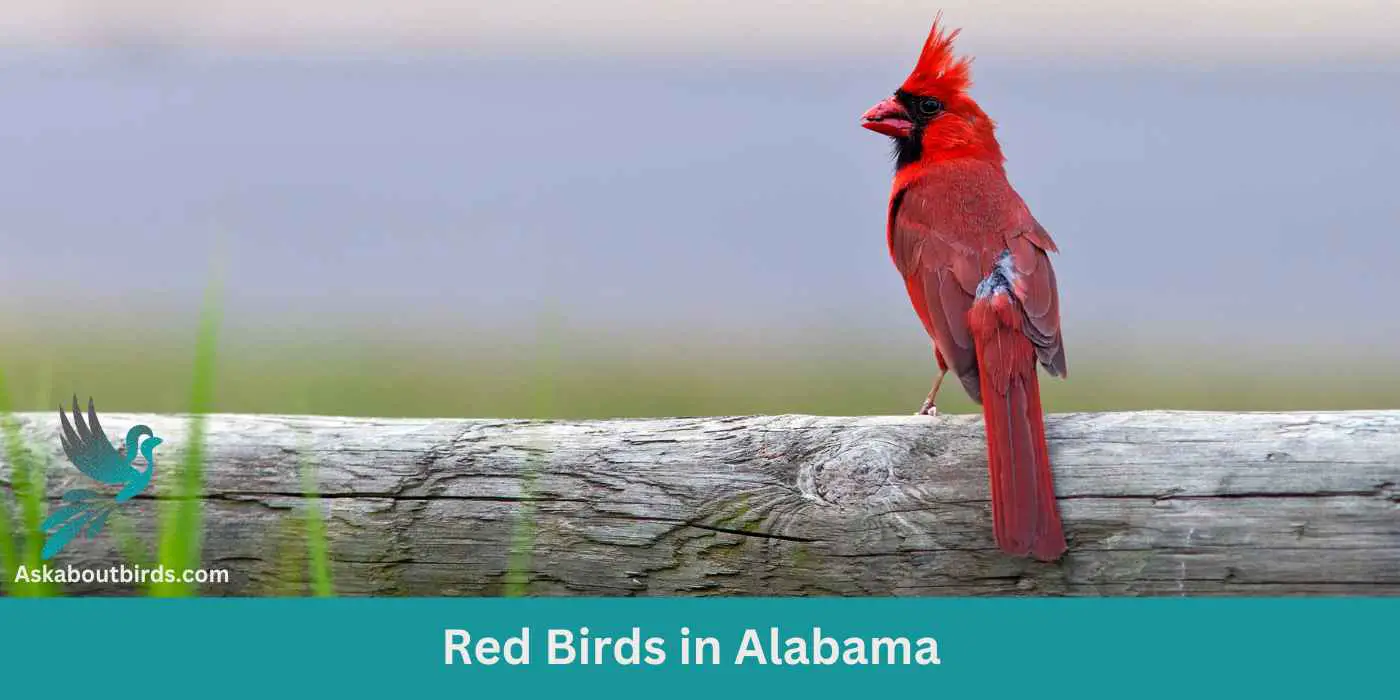Dive into the heart of Alabama’s avian splendor with our guide to 10 radiant red birds. From the iconic Northern Cardinal to the stunning Scarlet Tanager, the Yellowhammer State is teeming with crimson-hued wonders.
This mix of terrain and its role as a migratory crossroads contribute to Alabama’s rich avian biodiversity, making it a hotspot for bird enthusiasts seeking both common and rare sightings.
Red Birds Found In Alabama
Alabama boasts a diverse geography, from its Gulf Coast beaches to the Appalachian foothills. The varied landscapes of Alabama, encompassing coastal areas, wetlands, forests, and rolling hills, provide an array of habitats that attract a wide spectrum of bird species. The state’s strategic position along the Mississippi Flyway, a significant migratory path, brings in a host of seasonal birds that mingle with the resident species.
Northern Cardinal


| Feature | Measurement |
|---|---|
| Scientific Name | Cardinalis cardinalis |
| Length | 8.3 – 9.1 in |
| Wingspan | 9.8 – 12.2 in |
| Weight | 1.19 – 2.29 oz |
The Northern Cardinal is an iconic North American bird, easily recognized by its vibrant color and melodious song.
Appearance: Male Northern Cardinals are a brilliant scarlet red, while females display a more subdued reddish olive. Both sexes have a distinctive black ‘mask’ on their face around the bill and a pointed crest on their head. The bird’s beak is robust, cone-shaped, and bright orange in color.
Diet: Northern Cardinals are primarily granivorous, with a diet largely consisting of seeds and grains. They also eat fruits and insects. These birds typically feed off the ground and are frequent visitors to bird feeders.
Reproduction: Northern Cardinals are monogamous, and a pair will breed together for life. The female typically builds a well-hidden nest in a dense thicket or shrub. She lays 2-5 eggs per clutch, which she incubates for around two weeks.
Summer Tanager


| Feature | Measurement |
|---|---|
| Scientific Name | Piranga rubra |
| Length | 6.7 in |
| Wingspan | 28 to 30 cm |
| Weight | 29 g |
The Summer Tanager is a medium-sized songbird admired for its radiant plumage and melodious song.
Appearance: Male Summer Tanagers are an impressive bright red, while females and juveniles present a softer, yellow-orange color. Both genders have a large, slightly hooked bill and relatively short tail.
Diet: Summer Tanagers primarily feed on insects, including bees and wasps, which they catch in flight or pick off vegetation. They are also known to eat fruits and berries, making them helpful in controlling pest populations and seed dispersal.
Reproduction: The female Summer Tanager builds a loose, shallow cup-shaped nest out of twigs and grass, usually hidden in the foliage of trees. The female typically lays 3-5 eggs, which she will incubate for about two weeks.
Scarlet Tanager


| Feature | Measurement |
|---|---|
| Scientific Name | Piranga olivacea |
| Length | 6.3 to 7.5 in |
| Wingspan | 9.8 to 11.8 in |
| Weight | 23.5 to 38 g |
The Scarlet Tanager is a strikingly colorful bird known for its brilliant plumage and distinctive song.
Appearance: Male Scarlet Tanagers are notable for their vibrant scarlet bodies contrasted with black wings and tail, making them one of the most intensely colored birds. Females and juveniles, on the other hand, have a subdued olive-yellow body color with darker wings and tail.
Diet: The diet of the Scarlet Tanager is largely made up of insects, including beetles, cicadas, aphids, and others. They are adept flycatchers, seizing insects in mid-air or picking them off foliage. They also consume fruits and berries, especially during migration and in their winter habitats.
Reproduction: The female Scarlet Tanager builds a cup-shaped nest using twigs, rootlets, and grass, typically well-hidden in the dense foliage of trees. She lays 3 to 5 eggs and incubates them for about two weeks.
Red-headed Woodpecker

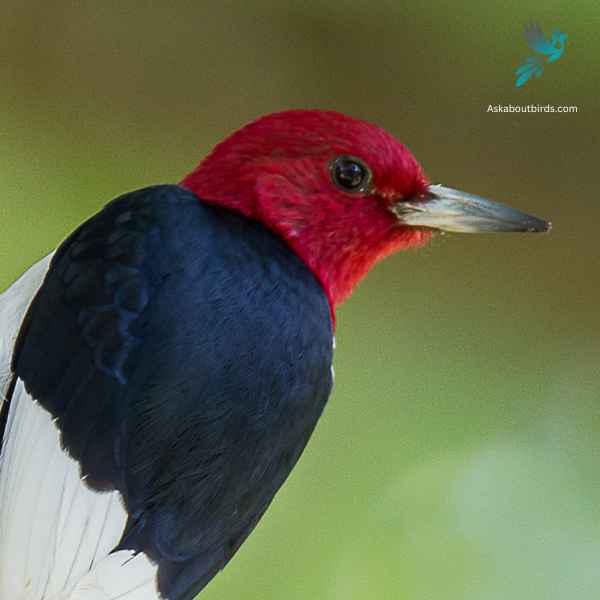
| Feature | Measurement |
|---|---|
| Scientific Name | Melanerpes erythrocephalus |
| Length | 7.5–9.1 in |
| Wingspan | 16.5 in |
| Weight | 2.0–3.2 oz |
The Red-headed Woodpecker is a striking forest bird with a bold tri-colored pattern.
Appearance: This woodpecker features a completely red head and neck, contrasting starkly with its white underparts and black wings. Its wings also have large white patches which are conspicuous in flight.
Diet: Red-headed Woodpeckers have a varied diet including insects, seeds, fruits, berries, and occasionally even the eggs of other birds. They’re also known to store food by wedging it into crevices in bark.
Reproduction: These woodpeckers nest in cavities which they excavate in dead wood or dead parts of live trees. These cavities can be found anywhere from 2 to 80 feet off the ground.
Red-bellied Woodpecker
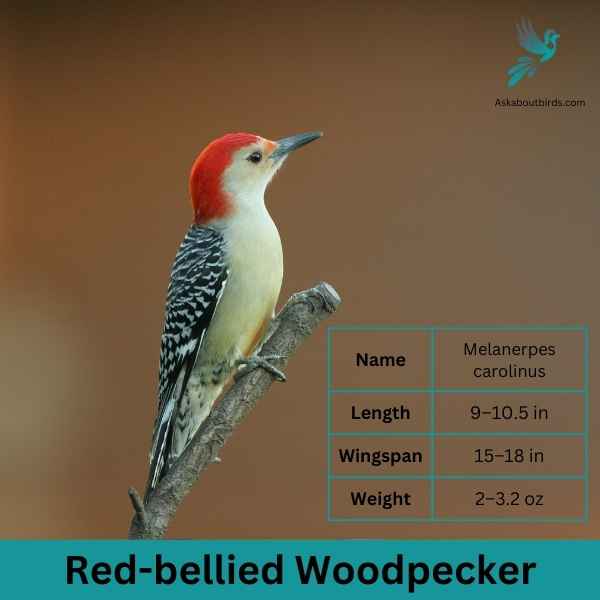
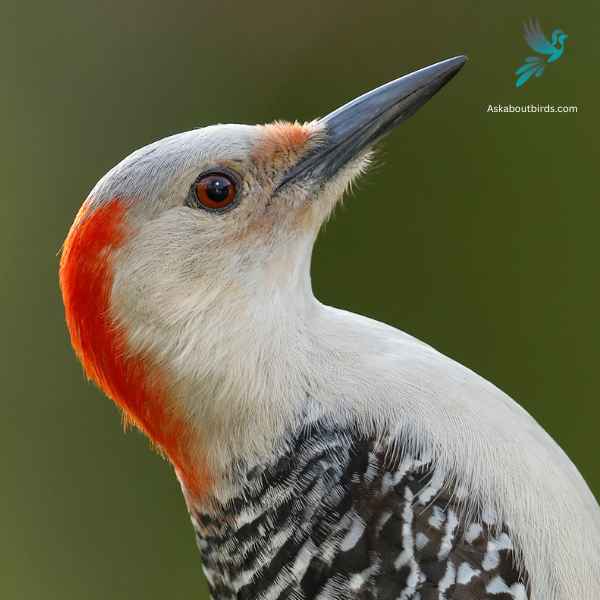
| Feature | Measurement |
|---|---|
| Scientific Name | Thryothorus ludovicianus |
| Length | 4.7–5.5 in |
| Wingspan | 11 in |
| Weight | 0.63–0.81 oz |
The Red-bellied Woodpecker is a medium-sized woodpecker commonly found in woodlands, forests, and backyards across the eastern and central U.S.
Appearance: The Red-bellied Woodpecker sports a pale gray face, throat, and belly, contrasted by a zebra-striped back. Its name derives from the subtle reddish tinge on its belly, but it’s more commonly recognized by the vivid red cap on the head of males and the partial red cap on females.
Diet: This woodpecker has a varied diet that includes insects, fruits, nuts, and seeds. They frequently forage on tree trunks and branches, using their sticky, barbed-tipped tongue to extract ants, beetles, and other insects from crevices.
Reproduction: Red-bellied Woodpeckers are cavity nesters, excavating holes in tree trunks for their nests. The inside of the nest is typically unlined or sparingly lined with wood chips.
Red Crossbill

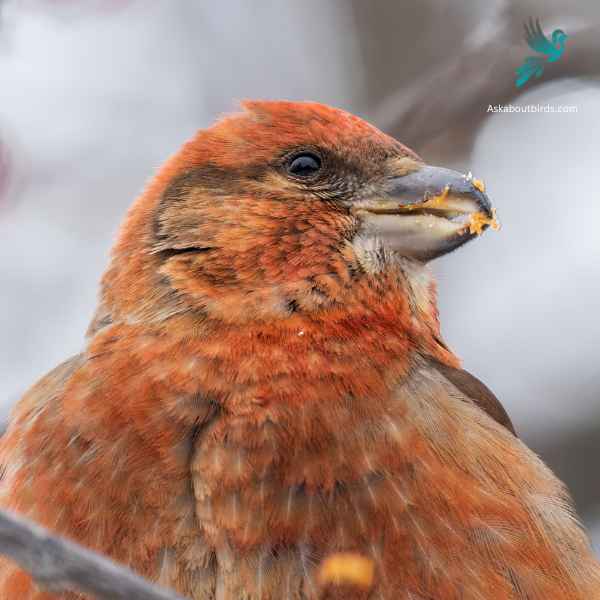
| Feature | Measurement |
|---|---|
| Scientific Name | Loxia curvirostra |
| Length | 5.5–7.5 in |
| Wingspan | 9.8–10.6 in |
| Weight | 0.9–1.4 oz |
The Red Crossbill is a distinctive finch known for its unusual bill, which has evolved to extract seeds from conifer cones.
Appearance: Males are typically bright red or orange, while females are greenish-yellow or olive. Both genders have the characteristic crossed bill, which they use to expertly extract seeds from tightly closed conifer cones.
Diet: Red Crossbills primarily feed on the seeds of coniferous trees, such as spruce, pine, and fir. Their specialized bills allow them to efficiently pry apart conifer cone scales to access the seeds.
Reproduction: Red Crossbills are somewhat nomadic and don’t adhere to a strict breeding schedule. Instead, they breed whenever and wherever food is abundant. Their nests are usually built on horizontal branches of conifer trees.
House Finch


| Feature | Measurement |
|---|---|
| Scientific Name | Haemorhous mexicanus |
| Length | 5–6 in |
| Wingspan | 8–10 in |
| Weight | 0.6–0.9 oz |
The House Finch is a small songbird widely distributed across North America and is commonly found in urban and suburban areas.
Appearance: Males of this species are brightly colored with crimson faces and throats, which can extend to the chest and back, while their flanks have streaks. The female is streaked brown and lacks the red coloring. Both have a square-tipped tail and a distinctively long, flat-topped bill.
Diet: House Finches primarily eat seeds, grains, and berries. They have a particular fondness for sunflower seeds and can be commonly seen at bird feeders. Occasionally, they will also consume insects, especially during the breeding season.
Reproduction: House Finches are cavity-nesters and might choose ledges, vents, ledges, and other urban settings. They might also utilize trees or shrubs. Their nests can be made of a wide array of materials, from feathers to twigs.
Purple Finch


| Feature | Measurement |
|---|---|
| Scientific Name | Haemorhous purpureus |
| Length | 4.7–6.3 in |
| Wingspan | 4.7–6.3 in |
| Weight | 0.6–1.1 oz |
The Purple Finch is a vibrant songbird often mistaken for its close relative, the House Finch, but it exhibits a different hue and patterns.
Appearance: Males are raspberry red on the head, throat, and breast, with streaky brown backs and wings. The intensity of the red can vary among individuals. Females are brown and streaked all over but might show a slight blush on the face. They lack the strong facial patterns seen in female House Finches.
Diet: Purple Finches primarily consume seeds, with a preference for sunflower seeds, dandelion seeds, and buds. They also eat insects and berries, especially during the breeding season.
Reproduction: These finches often nest in conifers or mixed woodlands. The nest, typically located on a horizontal branch, is made from twigs and grass, then lined with feathers.
Rufous-sided (Eastern) Towhee
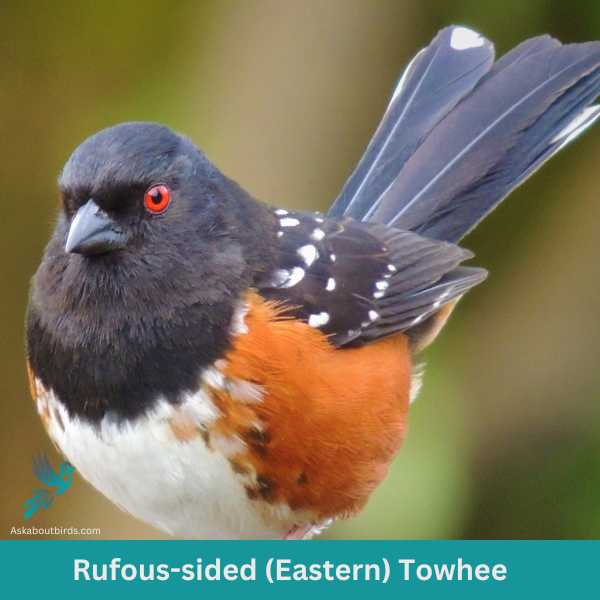
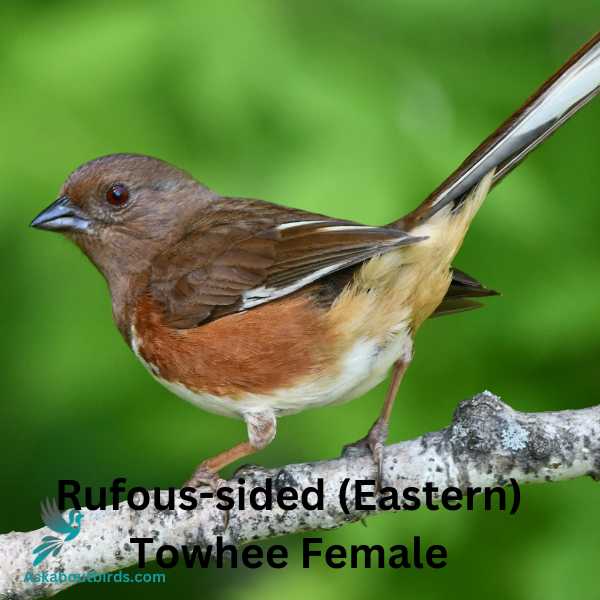
| Scientific Name | Pipilo erythrophthalmus |
| Length | 6.75 to 8.25 inches |
| Wingspan | 7.9 to 11 inches |
| Weight | 1.1 to 1.8 ounces |
The Rufous-sided Towhee, more commonly known as the Eastern Towhee, is a striking bird distinguished by its vivid coloration and melodious calls.
Appearance: Male Eastern Towhees are characterized by their black upper bodies, rufous flanks, and white underbellies. Females share the same pattern but are brown where the males are black. Both sexes have a distinctive red eye.
Diet: Eastern Towhees primarily feed on the ground, rummaging through leaf litter for seeds, berries, and insects. Their diet can vary seasonally, with more insects in warmer months and seeds during winter.
Reproduction: Eastern Towhees nest on or near the ground, typically in shrubs or dense vegetation. The female constructs the nest and incubates a clutch of 2 to 5 eggs, which hatch after about 12 days.
Red-Winged Blackbird
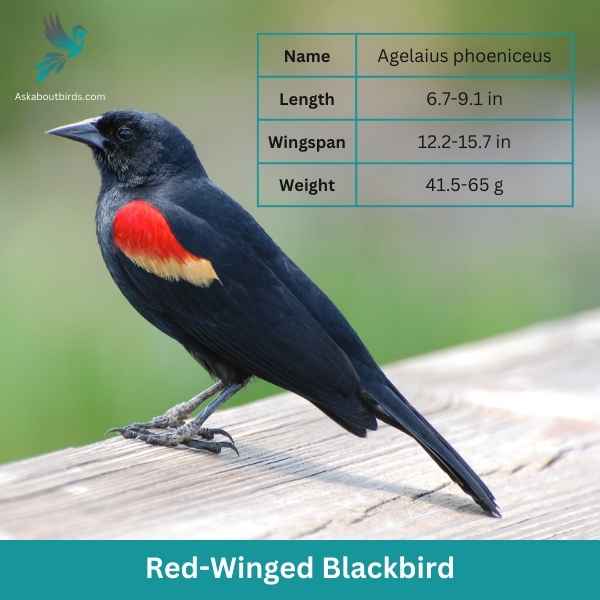
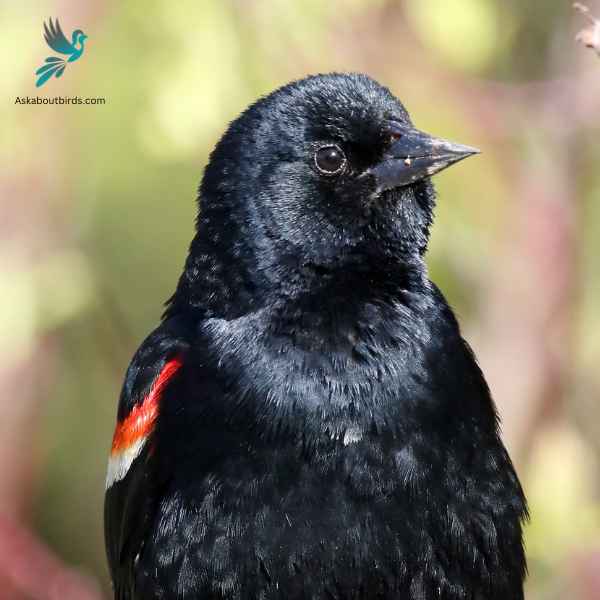
| Feature | Measurement |
|---|---|
| Scientific Name | Agelaius phoeniceus |
| Length | 6.7-9.1 in |
| Wingspan | 12.2-15.7 in |
| Weight | 41.5-65 g |
The Red-Winged Blackbird is a familiar sight across North America, especially in wetlands and open areas. Known for its striking coloration and distinct call, it is often seen perched on cattails or utility lines.
Appearance: Male Red-Winged Blackbirds are glossy black with bright red-and-yellow shoulder patches, while females are streaky brown, resembling a large sparrow. The males’ red patches become more prominent when they’re displaying or agitated.
Diet: Red-Winged Blackbirds primarily feed on seeds and insects. Their diet includes grains, sunflower seeds, and corn, but they also eat beetles, caterpillars, and other small invertebrates, especially in the breeding season.
Reproduction: Red-Winged Blackbirds nest in marshes, along watercourses, and in wet fields. The female constructs a cup-shaped nest using grass and sedge, attaching it to plants above water. She typically lays a clutch of 3 to 4 blue-green eggs, which she incubates for about 11-12 days. Males, being polygynous, often have multiple mates during a single breeding season.
Where to Spot Alabama’s Red Birds
Alabama’s rich tapestry of habitats makes it a birdwatcher’s dream. Here are the top spots in the Heart of Dixie to marvel at the diverse avian wonders, particularly the radiant red species:
- Dauphin Island: A renowned hotspot for bird migration, this barrier island becomes a resting point for countless species, including many red birds, during their long migratory journeys.
- Wheeler National Wildlife Refuge: Located along the Tennessee River, this refuge provides habitat for over 295 bird species, making it a must-visit for spotting an array of red birds amid a backdrop of wetlands, forests, and grasslands.
- Bankhead National Forest: Encompassing over 180,000 acres, this forest in northwestern Alabama offers a mix of pine and hardwood forests, streams, and hills, making it a haven for various bird species.
- Oak Mountain State Park: As Alabama’s largest state park, it presents birders with a mosaic of habitats from woodlands to wetlands. The park’s bird trail is especially popular for spotting both migratory and resident red birds.
- Cahaba River National Wildlife Refuge: Home to the largest free-flowing river in Alabama, this refuge is not just about the famous Cahaba lilies but also serves as a sanctuary for a plethora of bird species, including those with fiery plumage.
| State’s Red birds | Best Spots for Red Birds |
|---|---|
| Tennessee’s Red birds | 1. Great Smoky Mountains National Park 2. Radnor Lake State Park 3. Reelfoot Lake State Park |
| Georgia’s Red birds | 1. Okefenokee Swamp 2. Cochran Shoals (Chattahoochee River) 3. Kennesaw Mountain National Battlefield Park |
| Florida’s Red birds | 1. Everglades National Park 2. Ding Darling National Wildlife Refuge 3. Corkscrew Swamp Sanctuary |
| Mississippi’s Red birds | 1. Noxubee National Wildlife Refuge 2. Gulf Islands National Seashore 3. St. Catherine Creek National Wildlife Refuge |
FAQs on Red Bird Species Found in Alabama
Which red birds with bright red plumage are commonly sighted in Alabama’s deciduous forests?
In the deciduous forests of Alabama, bird enthusiasts are likely to spot the Summer Tanager, especially the males who sport a brilliant red plumage. Another bird with bright red coloration that can be observed in Alabama is the Northern Cardinal, characterized by its distinctive crest and often perched on tree branches within the forest canopy.
What kind of feed attracts red birds like Summer Tanager males and Rose Breasted Grosbeaks to backyard feeders in Alabama?
To attract red birds such as Summer Tanager males and Rose Breasted Grosbeaks to backyard feeders in Alabama, homeowners can offer black oil sunflower seeds. These seeds are a favorite among many bird species and are a common sight in backyard feeders. Additionally, sunflower seed mixtures can also entice a variety of other birds, enhancing the birdwatching experience.
Are Painted Buntings commonly seen in Alabama’s forest edges and scattered trees?
Yes, Painted Buntings, known for their striking combination of colors including bright red on the males, are fairly common in Alabama, especially around forest edges with scattered trees. The males are particularly eye-catching with their vibrant hues, while females display a more muted brown plumage. These little birds often forage on the ground or perch on exposed branches, making them a delightful sight for birdwatchers.
Do Ruby Throated Hummingbirds, known for their red throats, breed in Alabama?
Indeed, Ruby Throated Hummingbirds, characterized by their brilliant red throats in males, are breeding birds in Alabama. They migrate from Central America and Mexico, reaching as far north as southern Canada. During the breeding season, they can be commonly observed in Alabama’s forest edges and deciduous forests, hovering around flowers or feeders to sip nectar.

